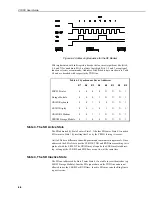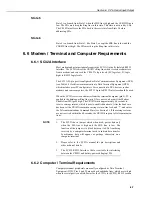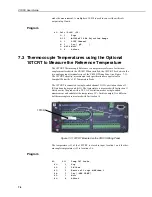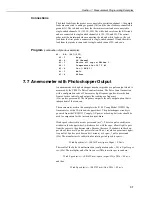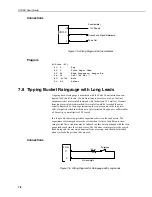
CR10X User Guide
6-10
received from such a modem, especially when implemented by computer soft-
ware. Please contact Campbell Scientific for further details.
To overcome the limitations of half duplex, some communications links expect a
terminal sending data to also write the data to the screen. This saves the remote
device having to echo that data back. If, when communicating with a Campbell
Scientific device, characters are displayed twice (in pairs) it is likely that the
terminal is set to half duplex rather than the correct setting of full duplex.
If Nothing Happens
If the CR10X is connected to the SC32A RS232 interface and a modem/terminal,
and ‘*’ is not received after sending carriage returns:
1.
Verify that the CR10X has power at the 12V and ground inputs, and that the
cables connecting the devices are securely connected.
2.
Verify that the port of the modem/terminal is an asynchronous serial com-
munications port configured as DTE (see Table 6-3). The most common
problems occur when the user tries to use a parallel port, or doesn’t know the
port assignments, i.e. COM1 or COM2. IBM PCs, and most compatibles,
come with a diagnostic disk which can be used to identify ports and their
assignments. If the serial port is standard equipment, then the operator’s
manual should give you this information.
3.
Verify that there is 5 volts between the CR10X 5V and G terminals. Call
Campbell Scientific if the voltage is less than 4.8 volts.
Some serial ports, e.g. the Super Serial Card for Apple computers, can be
configured as DTE or DCE with a jumper block. Pin functions must match with
Table 6-3.
If you are using a computer to communicate with the datalogger, communication
software must be used to enable the serial port and to make the computer function
as a terminal. Campbell Scientific’s Datalogger Support Software provides this
function for PCs. The port should be enabled for 300, 1200 or 9600 baud, eight
data bits, one stop bit and no parity.
If you are not sure that your computer/terminal is sending or receiving characters,
there is a simple way to verify it. Make sure that the duplex is set to ‘full’. Next,
take a paper clip and connect one end to pin 2 and the other end to pin 3 of the
serial port. Each character typed on the keyboard will be displayed only if
transmitted from the terminal on pin 2, and received on pin 3 (if duplex is set to
half, the character will be displayed once if it is not transmitted, or twice if it is
transmitted).
If Garbage Appears
If garbage characters appear on the display, check that the baud rate is supported
by the CR10X. If the baud rate is correct, verify that the computer/terminal is set
for eight data bits, and no parity. Garbage will appear if seven data bits and no
parity are used. If the computer/terminal is set to eight data bits and even or odd
parity, communication cannot be established.











